|
Home of
10 South Carolina Governors
|
|
|
|
|
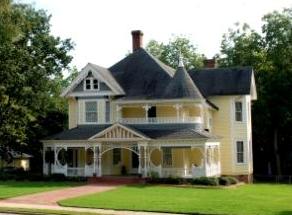
Adams
House. This house is believed to have been built sometimes around 1890 by W.W. Adams, a prominent merchant
and long-time mayor of Edgefield. It is of a classic Victorian design and has been credited to George F. Barber of Knoxville,
Tennessee, who published books of Victorian-era house plans in the period 1890-1910. One could order the house of his
choice, and it would be delivered by boxcar. When Mr. Adams died in 1913 he was one of the wealthiest men in the Town.
His family continued to own the house up until the mid twentieth century.
|
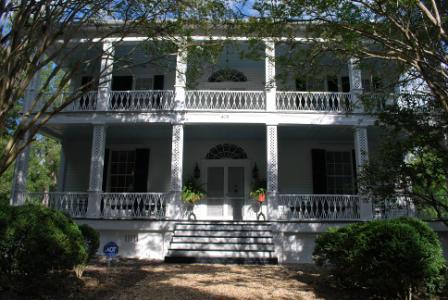
Halcyon Grove. A house was
on this site prior to 1824 when Eldred Simkins deeded the property to Daniel Bird. Bird owned the property until 1829
when he sold it to Francis Pickens. Pickens must have given or sold the house to his father, former Governor Andrew
Pickens who sold it in 1836 to John Lipscomb, stating that the property is “where I now reside.” In 1869,
Shemuel Wright Nicholson purchased the property for his daughter, Lucy Jane, widow of Capt. John Pearson Bates, CSA.
The house continued to be owned by this family until 2008. This early plantation home has many interesting architectural
features, including front windows with hidden doors below which can be raised and opened to allow movement from the front
rooms to the front porch. Also the house has beautiful wainscoting which has been feather-painted, an intricately carved
archway, a hidden staircase, bushels-of-wheat banisters with lattice columns and a magnificent fanlight over the front door.
|
|
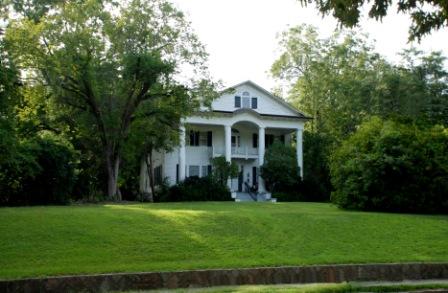
Brooks-Tompkins House. This
house was built circa 1818 by Whitfield Brooks (1790-1851), a prominent lawyer and Commissioner of Equity of the Edgefield
District. His eldest child, Preston S. Brooks, who became Congressman and who attained national fame in 1856 when he
caned Sen. Charles Sumner on the floor of the U.S. Senate, was born here. After his parents retired to their country
plantation in 1849, Preston moved back into the house with his family. The home was later purchased by Rev. Luther Gwaltney,
the well-known Baptist minister, who lived there for some years. Around the turn of the 20th century, the house was
purchased by Dr. James Glover Tompkins, a prominent local physician, whose family has continued to own it until the present
time. In 1924 the house was partially burned, but was rebuilt by Dr. Tompkins, using many of the architectural adornments
of the original house, including mantelpieces, wainscotings and fanlights. The elaborate carvings are of an unusual
style in Edgefield, only found in one other house, Holmewood.
 |
|
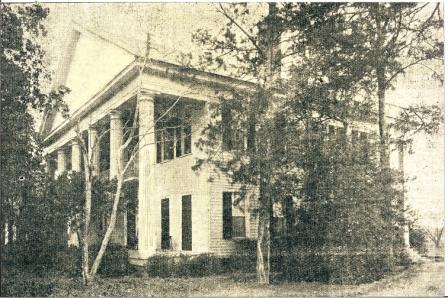
Pine House. This historic
landmark dates from 1757 when a tract of 200 acres “known by the name of the Piney Wood House” was surveyed for
Richard Pace. It was located at the junction of two important trails: one from Augusta to Columbia and the other from
Charleston to Ninety Six. In 1786 the property was acquired by Van Swearingen who operated it as a Tavern.
President George Washington dined here on May 21, 1791 during his Southern tour. In 1811 it was purchased by Francis
Bettis of the Horn’s Creek section. General J.R. Wever purchased property across the Augusta and Columbia Road
from the tavern in 1847 and erected “the Wever Mansion.” This Greek Revival house was purchased in 1858
by Benjamin Warren Bettis, who renamed it “the Pine House.” It partially burned in 1868 and was rebuilt
shortly afterwards. Julius M. Vann, Sr. bought the house in 1933 and it remains in that family into the 21st century.
The 1757 Piney Wood Tavern across the road was dismantled early in the 20th century.
 |
|
|
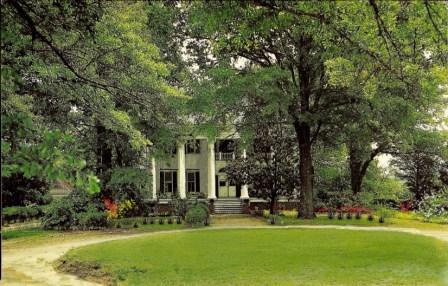
Holmewood. Built in 1832
by William Prothro, a wealthy planter, and his wife Sara Ann Lowe, a granddaughter of Edgefield founder Arthur Simkins, Holmewood
is one of the largest houses in Edgefield with some of the finest hand-carved woodwork in the area. The house was purchased
in 1846 by Francis Hugh Wardlaw (1800-1861), a prominent local lawyer and judge of the Chancellery Court who lived here until
his death in 1861. Wardlaw is best remembered as the author of the South Carolina Ordinance of Secession. Between
1865 and 1875, former Governor Milledge Luke Bonham (1813-1890) lived here with his family. Governor Bonham had been
a U.S. Congressman, Confederate General and second War Governor of South Carolina. In 1903 the property was purchased by Thomas
Hobbs Rainsford (1861-1932) whose family has resided here ever since.
|
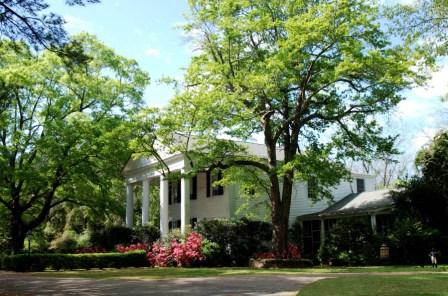
Carroll Hill. Built in 1842
by James Parsons Carroll, a prominent lawyer of Edgefield, and his wife, Eliza Anciaux Berrien of Savannah, Carroll Hill has
unique architectural features that includes a floor plan with the hallway on the side and a floating staircase, which suggest
the Savannah origin of its first mistress. The Carrolls lived here until 1859 when they moved to Columbia so that he
could assume a position there as a judge of the Chancellery Court. At this time, his niece, Ellen Brooks Dunovant, and
her husband, R.G.M. Dunovant, moved into the home. Dunovant was a prominent military figure in South Carolina, having
served as Colonel of the Palmetto Regiment in the Mexican War and as a Brigadier General in the Civil War. The Dunovant
family has continued to own this property for nearly 150 years.
|
|
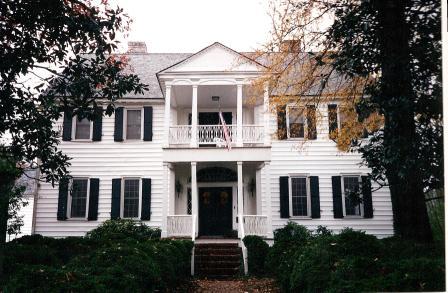
Cedar Grove. This is
one of the earliest of the grand plantation houses of Edgefield County. Built by a prosperous early settler, John
Blocker, sometime between 1790 and 1805, this house has many remarkable architectural features, including a curved ceiling
in the hallway, elaborately carved mantelpieces, and hand-painted French wallpaper. The gardens were reputedly laid
out by Andre Michaux, the renowned botanist who had designed the gardens at Middleton Place in Charleston. The house
was purchased in 1825 by John Bones, a wealthy Augusta merchant, for his parents who had immigrated from Ireland. It
was handed down through the Bones, Hughes and Nicholson families who continued to own it until 1973. The famous boxwoods
of Cedar Grove were sold during the Depression to the Rockefeller family and placed in the gardens of the Governor’s
Palace in Williamsburg.
|
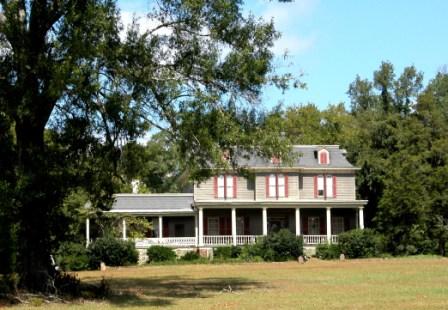
Carnoosie. This home, which
was originally built by M. Lebeschultz in 1860 as a one-story structure, is principally remembered as the home of the Sheppard
family. The home was purchased in 1884 by John Calhoun Sheppard, a prominent lawyer, politician and businessman who
became Governor of South Carolina in 1886. The house was first enlarged by the addition of the west wing and later,
in 1891, by a second story. Sheppard continued to be active in state and local politics and business for more than four
decades. His son, James Orlando Sheppard (1890-1973), who followed in his father’s footsteps becoming Lieutenant
Governor of South Carolina during the 1920’s, also lived here until his death. The name “Carnoosie”
is reputed to be a Cherokee word for cornfield, but it is unclear why and when the name was first applied to this house.
|
|
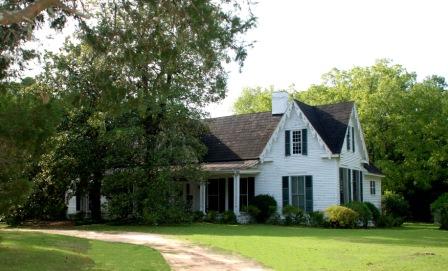
East Hill. This early Victorian
home, completed in 1859 for James Henry Mims, is very unlike other homes in Edgefield in that it is primarily one-story with
five main rooms across the front. It bears unique Victorian architectural features, including gingerbread trim around
the front porch and wide openings between the rooms, with multiple hinged doors. The house was purchased by General
Matthew Calbraith Butler in 1870. Butler had been a Major General in the Confederate Army and played a leading role
in the 1876 Red Shirt Campaign to restore Democratic government to South Carolina. He was elected to the United States
Senate in 1877 and served until 1895. Afterwards he was commissioned as a Major General in the Spanish American War.
In 1904 the house was purchased by Senator Benjamin Edwin Nicholson whose family continues to own the house today.
|
Darby. Built by Nathan Lipscomb
Griffin in 1842, this home was acquired by his son-in-law, Milledge Luke Bonham, in 1858. Bonham was a Congressman,
Governor and Confederate General. He lived here before the War and then later during Reconstruction. In 1863 Bonham
sold Darby to George Trenholm, a blockade runner who was reputedly the inspiration for Rhett Butler in Gone with the Wind
and who subsequently became the Confederate Treasurer. Trenholm allowed his friend Professor Francis Simons Holmes of
the College of Charleston to refugee here during the War. Holmes brought many artifacts from the Charleston Museum and
stored them at Darby. The house was purchased in the late 19th century by Walter S. Miller. After his death, his
widow left the property to her nephew, Douglas L. Wise who owned the house until his death. The property is now owned
by Mr. Wise’s daughter, Miss Clarice Wise.
|
 |
|
|
|
|
|